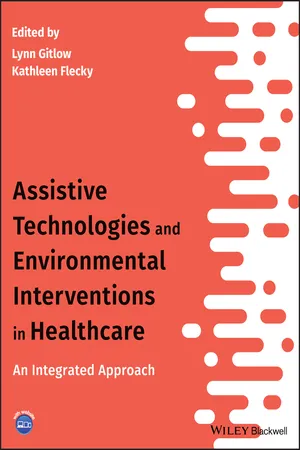
Assistive Technologies and Environmental Interventions in Healthcare
An Integrated Approach
- English
- ePUB (mobile friendly)
- Available on iOS & Android
Assistive Technologies and Environmental Interventions in Healthcare
An Integrated Approach
About this book
Providing a holistic and client-centered approach, Assistive Technologies and Environmental Interventions in Healthcare explores the individual's needs within the environment, examines the relationship between disability and a variety of traditional and cutting-edge technologies, and presents a humanistic discussion of Technology-Environment Intervention (TEI).
Written by a multidisciplinary team of authors, this text introduces readers to a variety of conceptual practice models and the clinical reasoning perspectives. It also provides insight into how designers go about solving human-tech problems, discusses best practices for both face-to-face and virtual teams, and looks at the psychological, sociocultural, and cognitive factors behind the development and provision of assistive technologies.
- Examines a wide range of technologies and environmental interventions
- Demonstrates how a better understanding of the complexity of human interaction with both the physical and social environment can lead to better use of technology
- Explores the future of technology and research in TEI
Complete with a range of learning features such as keywords, case studies and review questions, this book is ideal for undergraduate and graduate students in occupational therapy and other related health professions, as well as those undertaking certification and board examinations.
Frequently asked questions
- Essential is ideal for learners and professionals who enjoy exploring a wide range of subjects. Access the Essential Library with 800,000+ trusted titles and best-sellers across business, personal growth, and the humanities. Includes unlimited reading time and Standard Read Aloud voice.
- Complete: Perfect for advanced learners and researchers needing full, unrestricted access. Unlock 1.4M+ books across hundreds of subjects, including academic and specialized titles. The Complete Plan also includes advanced features like Premium Read Aloud and Research Assistant.
Please note we cannot support devices running on iOS 13 and Android 7 or earlier. Learn more about using the app.
Information
1
The person, the environment, and technology: Introduction to the human‐tech ladder
Outline
- The person, the environment, and technology: Introduction to the human‐tech ladder
- Models of disability
- Assistive technology and the environment
- Choosing the human‐tech ladder
- Human‐tech ladder
- Why are definitions important?
- Defining technology
- Defining AT
- Environmental interventions
- Categories of AT
- Summary
- References
Learning outcomes
- Describe human technology as a complex interaction between a person and the environment.
- Delineate distinguishing features of the Human‐Tech Ladder and a client‐centered approach.
- Describe the relationship between the Human‐Tech Ladder and assistive technology.
- Identify the components of the assistive technology continuum.
- Compare medical and social models of disability in relationship to a client‐centered focus on the Human‐Tech Ladder and assistive technology.
- Define assistive technology and environmental intervention.
Active learning prompts
- Describe the role that technology plays in your life in terms of how you interact with the environment on a daily basis to meet needed and desired tasks and goals.
- Complete a brief literature search using the keywords, client‐centered, health, disability and assistive technology, medical models of disability, and social models of disability.
- Using the website, www.resna.org, define assistive technology and locate the eligibility requirements for Rehabilitation Engineering and Assistive Technology Society of North America (RESNA) certification as an Assistive Technology Professional.
- Define assistive technology using two or more sources.
- Compare and contrast three definitions of assistive technology.
- Classify assistive technology in three different ways.
Key terms
- Assistive technology
- Assistive technology continuum
- Client‐centered
- Contextual factors
- Disability
- Disability models
- Environmental factors
- Environmental intervention (EI)
- Human‐Tech Ladder
- Technology
- Technology and environmental intervention (TEI)
The person, the environment, and technology: Introduction to the human‐tech ladder
Models of disability
Table of contents
- Cover
- Table of Contents
- List of contributors
- About the companion website
- 1 The person, the environment, and technology
- 2 Conceptual practice models and clinical reasoning
- 3 The design process
- 4 Funding in the United States
- 5 Outcomes, assessment, and research in assistive technology
- 6 Educational organizations
- 7 Technology, employment, and disability
- 8 Technology and environmental interventions for the home environment
- 9 Working and communicating in face‐to‐face teams
- 10 Working and communicating in virtual teams
- 11 Technology and environmental intervention
- 12 Sociocultural considerations
- 13 Technology and environmental interventions for cognition
- 14 Assistive technology to support learning differences
- 15 Seating and positioning factors in wheeled mobility
- 16 Positioning and mobility technology and environmental interventions other than wheeled mobility
- 17 Communication‐related factors
- 18 Hearing loss and hearing‐related factors: Technology and environmental interventions
- 19 Technology and environmental intervention for visual impairment
- 20 Technology and environmental interventions to promote community mobility
- 21 Leisure: Technology and environmental interventions
- 22 Physical factors focused on activities of daily living (ADLs) and electronic aids to daily living (EADLs)
- 23 Implications for future practice and research in technology and environmental interventions
- Index
- End User License Agreement